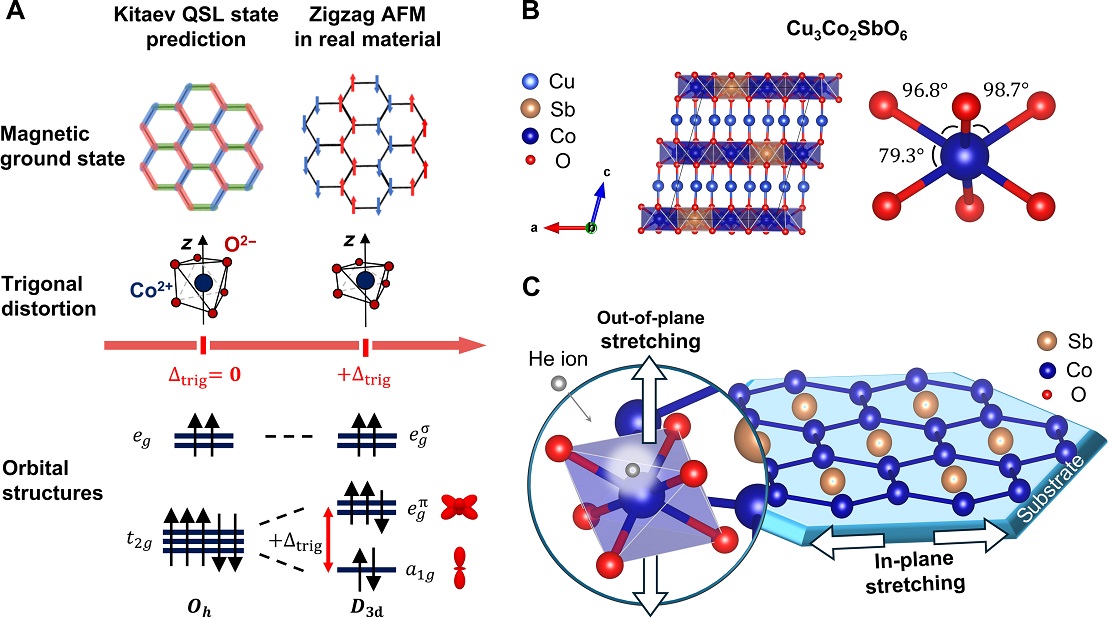Jul 31, 2024
JooHyeon Heo
Layered honeycomb cobaltates are promising candidates for achieving the Kitaev quantum spin liquid (QSL), a highly entangled many-body quantum ground state characterized by fractional excitations. However, their tendency to exhibit antiferromagnetic ordering at low temperatures complicates the realization of this state. Despite this challenge, QSLs are gaining attention as key materials for next-generation quantum computing, making their exploration in layered honeycomb cobaltates a significant area of research.
A joint research team, led by Professor Changhee Sohn of the Department of Physics at UNIST and Professor Heung-Sik Kim of the Department of Semiconductor Physics at Kangwon National University, has successfully increased quantum fluctuations in layered honeycomb cobaltates. This represents the world’s first confirmation of the potential to realize the Kitaev QSL.
In traditional magnets, electron spins align as temperature decreases, similar to water freezing into ice. In contrast, the spins in QSLs remain unaligned, preserving a liquid-like state even at cryogenic temperatures. This novel state of matter could enhance the development of ultra-fast quantum computers and innovative communication technologies.
The researchers controlled the deformation of the crystal structure by fabricating the layered honeycomb cobaltates into thin films, increasing quantum fluctuations and lowering the spin alignment temperature to less than half. Their findings demonstrate that lattice distortion is crucial for enhancing these quantum fluctuations.
The possibility of QSLs was proposed by Nobel laureate Professor Philip Anderson in 1973, but its implementation has been challenging. This difficulty stemmed from the fact that most quantum spin candidates did not exhibit strong quantum fluctuations, complicating efforts to suppress spin alignment.
Professor Sohn remarked, “This study revealed that the thin film structure can effectively control the spin interaction of QSL candidates,” adding, “If QSL is successfully implemented in the form of a thin film, it may pave the way for a topological quantum computer that does not require quantum error correction.”
The findings of this study have been published online in Science Advances on July 5, 2024. This research was conducted with support from the Ministry of Science and ICT (MSIT), the National Research Foundation of Korea (NRF), and the Pohang Accelerator Laboratory.
Journal Reference
Gye-Hyeon Kim, Miju Park, Subhasis Samanta, et al., “Suppression of antiferromagnetic order by strain-enhanced frustration in honeycomb cobaltate,” Science Advances, (2024).
Abstract
Layered honeycomb cobaltates are predicted as promising for realizing the Kitaev quantum spin liquid, a many-body quantum entangled ground state characterized by fractional excitations. However, they exhibit antiferromagnetic ordering at low temperatures, hindering the expected quantum state. We demonstrate that controlling the trigonal distortion of CoO6 octahedra is crucial to suppress antiferromagnetic order through enhancing frustration in layered honeycomb cobaltates. Using heterostructure engineering on Cu3Co2SbO6 thin films, we adjust the trigonal distortion of CoO6 octahedra and the resulting trigonal crystal field. The original Néel temperature of 16 kelvin in bulk Cu3Co2SbO6 decreases (increases) to 7.8 kelvin (22.7 kelvin) in strained Cu3Co2SbO6 films by decreasing (increasing) the magnitude of the trigonal crystal fields. The first-principles calculation suggests the enhancement of geometrical frustration as the origin of the suppression of antiferromagnetism. This finding supports the potential of layered honeycomb cobaltate heterostructures and strain engineering in realizing extremely elusive quantum phases of matter.





